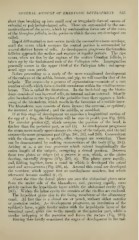Page 533 - My FlipBook
P. 533
GENERAL ACCOUNT OF EMBRYONIC DEVELOPMENT. 543 ;
short time breaking up into small oval or irregularly-formed masses of
cuboidal or polyhedral-shaped cells. These are surrounded by the con-
nective tissue of the ovary, which by condensation forms one of the coats
of the Graafian follicles, as the points in which the ova are developed are
called.
Kapid differentiation now occurs inside the connective-tissue envelope,
until the ovum which occupies the central portion is surrounded by
several distinct layers of cells. As development progresses the Graafian
follicles approach the surface and rupture at regular periods. The ripe
ovum, when set free by the rupture of the mature Graafian follicle, is
taken up by the fimbricated ends of the Fallopian tube. Impregnation
generally occurs in the upper third of the Fallopian tube : unimpreg-
nated eggs soon perish.
Before proceeding to a study of the more complicated development
of the embryo of the rabbit, human, and pig, we will consider that of the
tadpole. The ovum— by a process of segmentation—consists of a vast
number of cells which form a double membrane within the vitelline mem-
brane. This is called the blastoderm. In the fresh-laid egg the blasto-
derm consists of two layers of cells, an internal and an external. Shortly
after incubation in the region of the jyrimitive trace there appears a thick-
ening of the blastoderm, which results in the formation of a middle layer.
The blastoderm now consists of three layers : the external, or epiblast
the internal, or hypoblast; and the middle, or mesoblast.
If at this stage of development we examine a longitudinal section of
the Qgg of a frog, the blastoderm will be seen in profile (see Fig, 280).
The anterior portion (2), which occupies the position of the head, is
As development progresses
thicker than the posterior part, or tail (3),
the ovum more nearly approximates the shape of the tadpole, and the tail
assumes the more prominent part (Figs. 281, 282, and 283), Concomitant
with the changes seen in profile, other changes are occurring. These
can be demonstrated by making cross-sections of the body (Fig. 284),
Arising at A, A are two processes which extend longitudinally the
entire length of the tadpole, occupying a dorsal position. Between
these two plates or ridges (b) a groove is seen, which, as the plates
develop, naturally deepens (Fig. 285, b). The plates grow rapidly,
and, folding together, form a canal in which is developed the spinal
cord and nerve-centres (Fig, 286, b). Around this canal are developed
the vertebrse, which appear first as cartilaginous matrices, but which
afterward become ossified (c, c).
About the time the dorsal plates are seen the abdominal plates arise
from the under side of the blastoderm, and, growing rapidly, com-
])letely enclose the hypoblastic layer within the abdominal cavity (Fig,
287), Within the latter cavity the remains of the vitellus are enclosed.
The hypoblast gives rise to the lining membrane of the alimentary
canal. At first this is a closed sac or pouch, without either anterior
or posterior outlet. As development progresses, an involution of the
epiblastic layer, which finally unites with the hypoblastic layer of the
intestinal canal, gives rise to the mouth at the anterior part, while a
similar indipping at the posterior end forms the rectum (Fig. 283).
Having thus briefly considered the stages of development in the tad-


